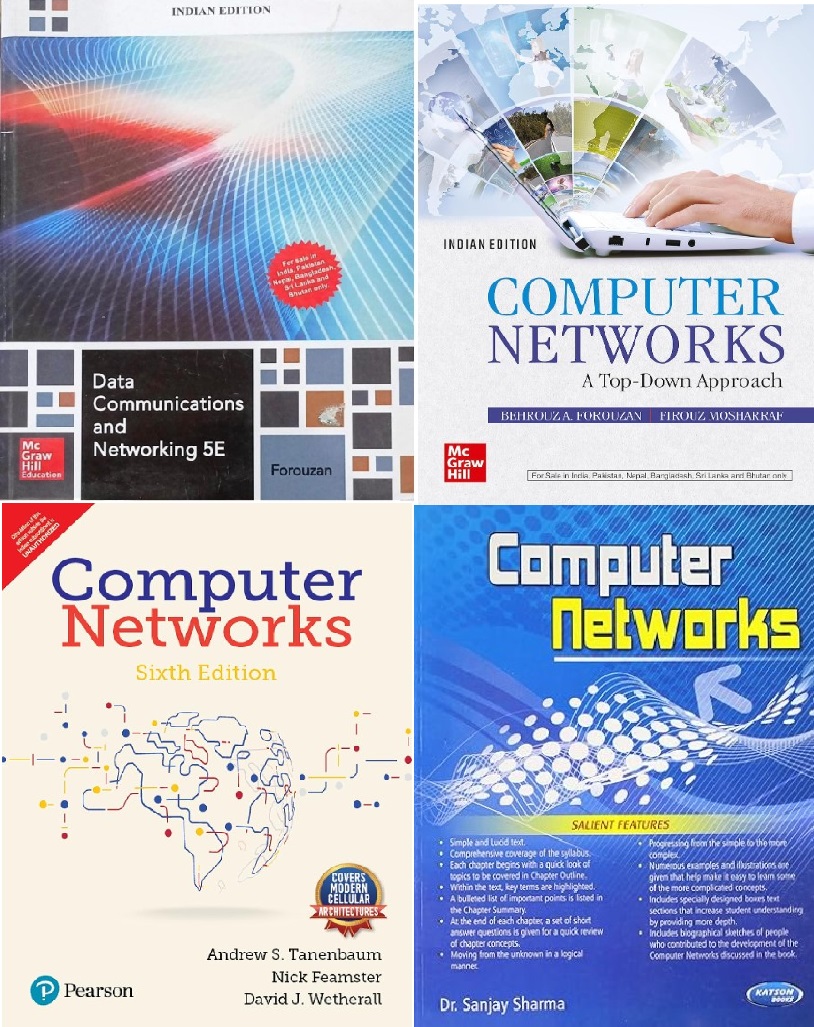Unit 1
Introduction to Data Communication Definition: Effectiveness, Basic Communication Components. Network Architecture Definition, History, Criteria, Goals and Applications of Networks, Categories of networks, Organization of the Internet, ISP, Protocols and standards, The OSI reference model, TCP/IP protocol suite, Network devices and components. Network topology design, Types of connections.
Q121 – In a broader sense, a railway track is an example of
Simplex
Half-duplex
Full-duplex
All of these
(Timothy Williams, McGraw Hill Education)
Ans – (2)
Explanation – A railway track typically allows for communication or travel in both directions, but not simultaneously in both directions on the same track. This is similar to a half-duplex communication system
Q122 – The frequency range at which the land coaxial cables will be used is
106 to 108 Hz
1010 to 1011 Hz
103 to 104 Hz
1014 to 1015 Hz
(Timothy Williams, McGraw Hill Education)
Ans – (1)
Explanation –
- Coaxial Cables: 106 to 108 Hz
- Optical Fiber Cables: 1014 to 1015 Hz
- Twisted Pair Cables: 103 to 104 Hz
Q123 – Match the following
(1). Data link layer
(2). Physical layer
(3). Presentation layer
(4). Network layer
(i). The lowest layer whose function is to activate, deactivate and maintain the circuit between DTE and DCE
(ii).Perform routing and communication
(iii).Detection and recovery from errors in the transmitted data
(iv).Provides for the syntax of the data.
(1)-(iii), (2)-(i), (3)-(iv), (4)-(ii)
(1)-(ii), (2)-(i), (3)-(iv), (4)-(iii)
(1)-(iv), (2)-(i), (3)-(ii), (4)-(iii)
(1)-(ii), (2)-(i), (3)-(iii), (4)-(iv)
(Timothy Williams, McGraw Hill Education)
Ans – (1)
Q124 – Which of the following is true?
The OSI model supports connectionless communication in the network layer
The OSI support both connection oriented and connectionless communication in the transport layer
TCP/IP model support connectionless mode in the network layer
TCP/IP support connection-oriented mode in transport layer.
Ans – (3)
Explanation –
- OSI model supports both connection oriented and connectionless communication in the network layer. Hence option 1 is false.
- OSI model supports connection-oriented communication in the transport layer. Hence option 2 is false.
- TCP/IP model support connectionless mode in the network layer. Hence option 3 is true.
- OSI model supports both connection oriented and connectionless communication in the network layer. Hence option 4 is false.
Q125 – Twisted pair cables transmit signals in the form of
Infrared light
Light
Radio waves
Electric current
Ans – (4)
Explanation – Twisted pair cables use electrical signals to transmit data. The twisted design helps to reduce electromagnetic interference from external sources and crosstalk between adjacent pairs within the cable.
Q126 – Arrange the following as per the year in which they came into existence
www
ARPANET
Wifi
TCP/IP
Choose the correct answer
2 -> 4 -> 1 -> 3
2 -> 1 -> 4 -> 3
3 -> 4 -> 1 -> 2
2 -> 4 -> 3 -> 1
Ans – (1)
Explanation –
ARPANET – ARPANET, the precursor to the internet, was established in 1969.
TCP/IP – The TCP/IP protocol suite was developed in the early 1970s.
www – The World Wide Web was proposed by Tim Berners-Lee in 1989 and became publicly available in 1991.
Wifi – Wifi technology was invented in the 1990s and became commercially available in the late 1997s.
Q127 – How many OSI layers are covered in the X.25 standard?
Two
Three
Seven
Six
Ans – (2)
Explanation –
The X.25 standard covers three layers of the OSI model: the Physical Layer, Data Link Layer, and Network Layer.
X.25 is a widely used standard for packet-switched wide area network (WAN) communication. It was developed in the 1970s by the International Telecommunication Union – Telecommunication Standardization Sector (ITU-T). X.25 defines the protocols for the interface between data terminal equipment (DTE) and data circuit-terminating equipment (DCE) for terminals operating in the public data network.
Q128 – The X.25 standard specifies a ……………
technique for start-stop data
technique for dial access
DTE/DCE interface
None of above
Ans – (3)
Explanation – X.25 is a widely used standard for packet-switched wide area network (WAN) communication. It was developed in the 1970s by the International Telecommunication Union – Telecommunication Standardization Sector (ITU-T). X.25 defines the protocols for the interface between data terminal equipment (DTE) and data circuit-terminating equipment (DCE) for terminals operating in the public data network.
Q129 – One computer can communicate to another computer by using
Port address
Physical address
Logical address
Specific Address
Ans – (3)
Explanation – One computer can communicate with another computer using logical addresses. Logical addresses, such as IP addresses, are used to identify devices on a network and enable communication between them.
Q130 – Which topology requires a central controller or hub?
Mesh
Star
Bus
Ring
Ans – (2)
Explanation – In a star topology, all nodes (computers or devices) are connected to a central hub or switch. The hub or switch serves as a central controller, managing and controlling the communication between the nodes. This centralized structure simplifies network management and troubleshooting but can also create a single point of failure.
Q131 – Which topology requires a multipoint connection?
Mesh
Star
Bus
Ring
Ans – (3)
Explanation –
In a bus topology, all nodes are connected to a single communication line, creating a shared communication medium. Each node in the bus network has a direct connection to the communication line, allowing for a multipoint connection where multiple nodes can transmit and receive data simultaneously.
Q132 – In mesh topology, every device has a dedicated topology of
Multipoint linking
Point to point linking
None of Above
Both a and b
Ans – (2)
Explanation – In a mesh topology, each device is connected to every other device through a dedicated point-to-point link. This means that each device has a direct connection to every other device in the network, forming a fully interconnected mesh of communication links. Therefore, the correct answer is option b. Point to point linking.
Q133 – Bus, ring and star topologies mostly used in the
LAN
MAN
WAN
Internetwork
Ans – (1)
Explanation –
These topologies are commonly used in LAN environments to connect devices within a limited geographic area, such as a single building or campus. Each of these topologies has its own advantages and disadvantages, making them suitable for different types of LAN deployments.
Q134 – Combination of two or more topologies are called
Star
Bus
Ring
Hybrid
Ans – (4)
Explanation – A hybrid topology is a combination of two or more different types of network topologies, such as star, bus, or ring, integrated into a single network.
Q135 – Star Topology is Based On a Central Device that can be __________?
HUB
Switch
Only a
Both a and b
Ans – (4)
Explanation – In a star topology, the central device can be either a hub or a switch. Both of these devices connect the various nodes in the network to facilitate communication.
Q136 – In a star-topology Ethernet LAN, _______ is just a point where the signals coming from different stations collide; it is the collision point.
An active hub
A passive hub
Either (a) or (b)
Neither (a) nor (b)
Ans – (2)
Explanation –
In a star-topology Ethernet LAN, a passive hub is a point where signals from different stations collide. Unlike an active hub, a passive hub does not amplify or regenerate the signals; it merely provides a physical connection point for the network devices.
Q137 – Security and privacy are less in a ……………… topology.
bus
mesh
star
tree
Ans – (1)
Explanation –
In a bus topology, all devices share a common communication line, making it easier for unauthorized users to access the network and intercept data. This shared medium can lead to lower security and privacy compared to other topologies like mesh, star, or tree.
Q138 – A network that contains multiple hubs is most likely configured in a …………… topology.
bus
mesh
star
tree
Ans – (4)
Explanation – A tree topology is a network configuration that contains multiple hubs, organizing the network in a hierarchical manner. This structure combines characteristics of both star and bus topologies, with multiple star-configured networks connected to a central bus.
Q139 – Source routing bridges in the same LANs must have …………… bridge Number.
Same
Different
Source
Destination
Ans – (2)
Explanation –
Source routing bridges in the same LANs must have different bridge numbers. This ensures that each bridge can be uniquely identified and properly route data within the network.
Q140 – Which network topology is considered passive?
Bus
Star
Ring
Cross
Ans – (1)
Explanation – In a bus topology, the network is considered passive because the nodes simply listen to the data being transmitted along the shared communication line and do not actively route or manage the data. The communication is managed by the devices themselves rather than a central node.



